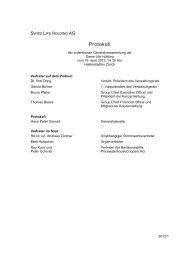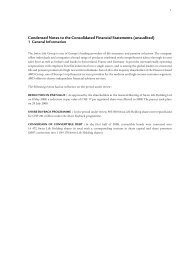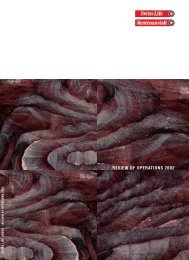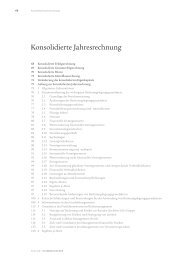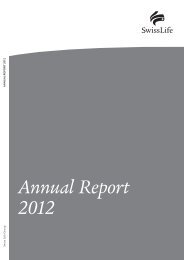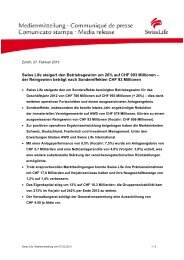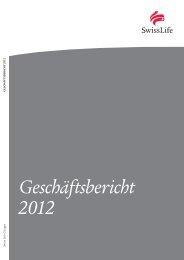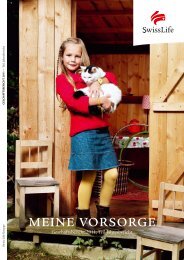Market Consistent Embedded Value (MCEV) - Swiss Life - Online ...
Market Consistent Embedded Value (MCEV) - Swiss Life - Online ...
Market Consistent Embedded Value (MCEV) - Swiss Life - Online ...
- No tags were found...
You also want an ePaper? Increase the reach of your titles
YUMPU automatically turns print PDFs into web optimized ePapers that Google loves.
<strong>Market</strong> <strong>Consistent</strong> <strong>Embedded</strong> <strong>Value</strong>43In CHF million Free surplus Required capital VIF <strong>MCEV</strong> <strong>MCEV</strong>2010 2009OPENING <strong>MCEV</strong> 319 2 005 1 808 4 132 3 569Opening adjustments –139 – – –139 –1ADJUSTED OPENING <strong>MCEV</strong> 180 2 005 1 808 3 993 3 567<strong>Value</strong> of new business –380 256 333 209 123Expected existing business contribution (reference rate) – 10 17 27 80Expected existing business contribution (in excess of reference rate) 9 –5 833 837 –Transfers from VIF and required capital to free surplus 666 –162 –504 – –Experience variances –376 60 45 –271 –174Assumption changes –47 – 1125 1 077 180Other operating variance –328 72 677 421 –15OPERATING <strong>MCEV</strong> EARNINGS – 456 230 2 527 2 301 194Economic variances 258 –119 –1 117 –979 581Other non-operating variances 86 – –12 75 –13TOTAL <strong>MCEV</strong> EARNINGS –112 111 1 398 1 397 763Closing adjustments –32 –224 –174 –431 –198CLOSING <strong>MCEV</strong> 35 1 892 3 032 4 959 4 132OPENING ADJUSTMENTS represent dividend paymentsfrom covered to non-covered business.VALUE OF NEW BUSINESS contributions from free surplusand required capital sum up to the new businessstrain of CHF –124 million (2009: CHF –133 million).This represents the shareholders’ share in acquisitionexpenses for new business. The VIF-component ofCHF 333 million (2009: CHF 255 million) is the value offuture risk-adjusted profits from new business.EXPECTED EXISTING BUSINESS CONTRIBUTION (REF-ERENCE RATE) shows the unwinding of discount on allvalue of in-force components with reference rates as atstart of year. Additionally the notional interest on thecomponents of the net asset value is included.EXPECTED EXISTING BUSINESS CONTRIBUTION (INEXCESS OF REFERENCE RATE) represents the additionalcontribution to <strong>MCEV</strong> by taking into account investmentreturns for the reporting period expected at the beginningof the period over and above the initial referencerates for the period. Also releases from the period’s contributionto the time value of financial options and guaranteesand cost of residual non-hedgeable risks areincluded. In <strong>Swiss</strong> <strong>Life</strong>’s previous <strong>MCEV</strong> reporting, thisstep was not separated; its effects were part of economicvariances. The expected business contribution dependson asset allocation and capital market conditions at startof the year.TRANSFERS FROM VALUE IN FORCE AND REQUIREDCAPITAL TO FREE SURPLUS include the transfer of theresults of the preceding step to free surplus and subsequentsplit between free surplus and required capital. Thetotal effect in this line is zero. As this step is carried outafter taking into account the contributions in excess ofreference rates the effect on free surplus is positive.EXPERIENCE VARIANCES aggregate the impact of actualperformance versus expectations on insurance contractsregarding non-economic assumptions such as mortality,expenses, lapses, as well as the deviations in handling ofadditional reserves. As a result of the low interest rateenvironment the situation in Switzerland was reassessedand subsequently reserves were strengthened.ASSUMPTION CHANGES refer to the impact of thechange on assumptions such as future mortality, morbidity,longevity rates, changes in anticipated surrenders andexpenses, and the approach to future profit sharing.These are commented on in section 3.2.OTHER OPERATING VARIANCE includes effects fromstrategic management decisions, modelling improvementsand other reassessments. Comments are providedin the section 3 (results per market unit).ECONOMIC VARIANCES represent the change in embeddedvalue by replacing the starting economic scenarios bythe closing ones. The effects from expected investment<strong>Swiss</strong> <strong>Life</strong> — Financial Statements 2010



